|
The majority of
my past columns have focused upon fish which generally can
be considered acceptable choices for reef aquariums, albeit
sometimes requiring larger aquariums than others. Such is
not the case with this month's column. I decided to change
gears slightly and discuss a genus which often is imported
with tiny juveniles, but which unfortunately can grow into
enormous adults. Along the way they have a tendency to swallow
most anything they can, and if fed properly, they have the
ability to grow to staggering proportions in seemingly no
time at all. Given proper consideration prior to purchase,
however, they can make an attractive impact on large show-fish
aquariums. Groupers of the genus Plectropomus, known
within the hobby as Coral Groupers, are the feature for March's
edition of Fish Tales.
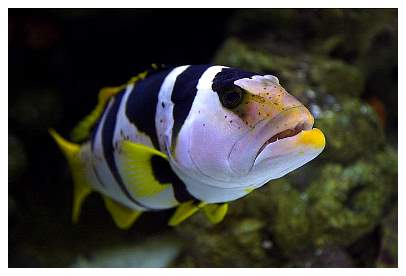 |
|
This Plectropomus laevis starts its life as a
small and attractive juvenile, but can grow up to four
feet in length and make a quick meal of any tankmates
that will fit into its mouth. Photo courtesy of Greg
Rothschild.
|
Meet the Family
Plectropomus,
the focal point for this month, is a member of the family
Serranidae, often called the Sea Bass family among the non-scientific
community. Besides containing Groupers, the Serranidae family
boasts Soapfishes and Cave Basses as other popular aquarium
genera. More recently, Anthias, which previously was
believed to warrant a separate family named Anthiidae, has
been reassigned as the subfamily Anthiinae under Serranidae.
Serranidae, in a state of continual reform
by ichthyologists, once consisted of only two subfamilies
but now is further divided into five subfamilies. In addition
to the extremely aquarium-popular Anthiinae, the remaining
four subfamilies are Epinephelinae, Grammistinae, Liopropomatinse
and Serraninae. Epinephelinae, which contains this month's
featured genus, is further divided into five tribes (Allen,
et al, 2003).
|
Tribes
of Epinephelinae
|
|
Niphonini
|
Epinephelini
|
|
Diploprionini
|
Liopropomini
|
|
Grammistini
|
|
Besides Plectropomus, an additional 13 genera are
classified in the tribe Epinephelini, which encompasses over
160 species. Distinguishing themselves from other Epinephelini,
Plectropomus all maintain a consistent dorsal-fin formula
(referred to as "VIII, 11" by ichthyologists) in
addition to three antrorse
spines on their preopercle's lower margin (Randall and Hoese,
1986). A total of seven distinct species are currently recognized
within Plectropomus. Of these seven species, six exhibit
"a color pattern of small blue spots on the head, body,
and median fins (which) become more numerous and relatively
smaller with growth." Additionally, "individuals
taken from moderately deep water (about 30m or more) tend
to be red" (Randall and Hoese, 1986). Finally, one subspecies
has been formally described and their distinction is based
solely upon color differences.
|
Serranidae
- Epinephelinae
- Plectropomus
- areolatus
- laevis
- leopardus
- maculatus
- pessuliferus
- punctatus
- oligacanthus
|
|
Regular readers of this column are well aware of the difficulty
ichthyologists encounter when trying to categorize genera.
Plectropomus' most recent revision includes this passage,
which I feel does a more than an adequate job of summing up
the research: "Few groups of fishes have been more confused
in the systematic literature than the genus Plectropomus"
(Randall and Hoese, 1986). As it is, Plectropomus'
first five species that were described, including one by Bloch
(1790) and four by Lacepede (1801, 1802), were placed into
errant genera. Cuvier (1816) recognized their similarities
and grouped the fish together, but he failed to assign a Latin
designation to them, instead leaving them grouped as "Les
Plectropomes." Plectropomus finally became a valid
genus after Oken (1817) reviewed Cuvier's work and appointed
them with the Latin name Plectropomus.
All this doesn't sound too confusing yet, does it? Well,
Quoy and Gaimard (1824), likely oblivious to Oken's work,
offered the name Plectropoma in honor of Cuvier. Cuvier,
who was apparently proud of Plectropoma, moved three
species into this genus and named an additional 10 new species
of the genus - none of which is a current member of Plectropomus.
Various authors, including Ruppel (1830) and Bleeker (1849),
continued to use Plectropoma while continuing to add
newly described species.
In an attempt to bring some organization to the genus, Gunther
(1859) revised Plectropoma and listed a total of 27
species in it. Unfortunately, as the systematic literature
stands today, he included species from eight different genera
into his Plectropoma revision. Boulenger (1895) brought
Gunther's errors into the limelight when he claimed only two
species of Plectropoma in his revision. Since Boulenger
(1895) recorded his two specimens, albeit with an errant generic
designation, it has been a gradual progression in the proper
direction to the point where we stand today. The genus began
its progression toward the proper classification when Jordan
(1917) ended the confusion between Plectropomus and
Plectropoma. Fowler and Bean (1930) reported four specimens;
Randall (1973) reported a fifth species; Hoese, et al
(1981) added a sixth unnamed species. Finally, as the above
listing indicates, we now have Randall and Hoese (1986) to
thank for their current classification.
In the Wild
Coral groupers populate
the Pacific Ocean's warm tropical waters. None of the seven
species is terribly limited, geographically speaking. In fact,
most species are fairly widespread and are not in short supply
on the reefs where they are located. Plectropomus pessuliferus
is perhaps the most limited of the bunch with its one subspecies,
P. pessuliferus marisrubri, found only in the Red Sea,
although it has been very populous there - so much so that
it was such an important food fish, regarded by some as the
most popular food fish (Schmid and Vine, 1985), that its numbers
are now considered threatened by overfishing. The other subspecies,
P. pessuliferus pessuliferus, is the exception in the
genus as it is fairly limited geographically. Additionally,
even where it has been found it is considered a rarity, found
only along Africa's east coast near Zanzibar (originally described
specimen), the Maldives (photographed only around 75 feet
deep), Sri Lanka (one specimen taken in trawl), Sumatra (one
specimen taken in trawl at 130 feet), Fiji (one specimen caught
on hook and line over 450 feet deep) and St. Brandon's Shoal
(three specimens). Of interest is that all these locations
excepting Fiji are in the Indian Ocean. Fiji is, of course,
located in the South Pacific. Given that the Fijian specimen
was collected from a depth of 450 feet, it is quite likely
that this species will be regarded as more popular than collections
currently indicate once further deep water research is conducted.
On the flipside is Plectropomus laevis. This species
populates much of the Indian, South Pacific and North Pacific
Oceans. Likewise, Plectropomus areolatus can be found
in many of the same waters as Plectropomus laevis,
but the former also occupies the Red Sea.
|
|
|
P. pessuliferus. Photo courtesy of Mary Jane
Adams.
|
As mentioned above, Plectropomus pessuliferus
is an important food fish in the Red Sea. It is not alone,
however, as the entire genus is well-regarded throughout the
Indo-Pacific as a worthy fillet. In Queensland alone the genus
Plectropomus has an estimated annual value of $10 million
Australian and $20 Australian/kilogram retail for its fillets.
Given the demand for fresh filets from these fish, it is rather
interesting to note that Plectropomus species are among
the highest carriers for Ciguatera
poisoning.
As the reader may have gleaned from the above information,
this genus' depth range is widely variable. In fact, depth
variances even within a single species are also highly variable.
Plectropomus areolatus can be located in water barely
deep enough to cover its entire body, yet also can be found
to nearly 100 feet. This is perhaps the genus' least variance
in depth, whereas the greatest variance would be found with
P. pessuliferus, which has been recorded from 30 feet
to 480 feet. Regardless of the depth, these Coral Groupers
relate almost exclusively to reef walls and steep drop-offs.
Caves or holes in the wall are utilized as bolt holes when
frightened, but otherwise the fish remains in the open, most
often trying to passively mingle with other shoals of fish.
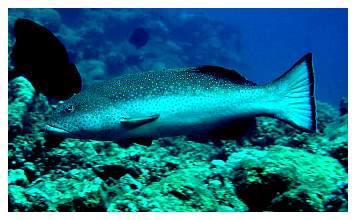 |
Plectropomus areolatus is perhaps the shyest
of all Coral Groupers. It is difficult to approach in
the wild and may take several days before acclimating
to a home aquarium. Photo courtesy of Richard Field
of http://www.richardfield.freeservers.com.
|
This passive mingling is nothing but an act. More accurately,
this passive persona is an integral part of their hunting
tactics. As the Coral Grouper gains the other fishes' acceptance,
their guard drops. Little by little the prey begins not only
to accept, but eventually to ignore, the predator. The end
result should be obvious - more often than not the predator
is victorious.
Prey can consist of anything that fits
into their mouth. Because Coral Groupers can reach over 24"
in length, with a mouth designed to engulf large catches whole,
this leaves them quite a sizeable menu to choose from. Their
preferred food item is other fish. In fact, in a sampling
of 468 Plectropomus leopadus that were caught and analyzed,
over 95% of their diet was determined to be other fish. Roughly
25% of their diet was fish from the Pomacentridae family,
followed closely by Labridae at 20%. It is not picky about
the types of fish it eats - anything too slow is inevitably
added to their dinner plate. A total of 22 families were identified
in these stomach contents (St. John, et al, 2000).
Rather surprisingly, two of the fish identified were from
the Scorpaenidae and Siganidae families. I say "surprisingly"
because those families' members are armored with poisonous
dorsal fins. Fish that have been retrieved from Plectropomus
species' gut include fish most often associated with sand
bottoms such as cardinalfish, all sorts of wrasses and parrotfish,
lizardfish, sand perches, gobies, goatfishes, etc. Even finds
of pelagic fish such as herring and smelt have been reported.
Coral Groupers are even among the few fish which have no qualms
about consuming the occasional cleaner wrasse of the genus
Labroides (Michael, 2004). In addition to their preference
for other fish, Coral Groupers also consume squid, shrimp
and other motile invertebrates. More or less, if it moves
and the grouper is hungry, it will be eaten.
Spawning has been well documented thanks to both Plectropomus
pessilerifus and the Red Sea's fishermen. The fishermen
report that in late May these fish gather into large schools
on shallow offshore reefs where spawning commences. This is,
however, the only time any Plectropomus species gather
into schools. Otherwise, these fish live singly as adults
except during spawning season, which results in all species
other than Plectropomus pessilerifus pairing up in
male-female pairs. Goeden (1978) spent an extended period
studying the biology of P. leopardus. The end result
was that he found P. leopardus to be a protogynous
hermaphrodite whose females begin sexual activity at approximately
200mm in total length, followed by their change to a functional
male anywhere after 200mm in total length. It is presumed
that the rest of the Plectropomus species are also
protogynous hermaphrodites.
In the Home Aquarium
Like most groupers,
Coral Groupers are exceptionally hardy in the home or public
aquarium, but there is one caveat: they grow very large.
Okay, so maybe there are two caveats - Coral Groupers also
have a tendency to consume their tankmates. Despite being
easy to care for and generally disease resistant, certain
precautions must be taken to in order to ensure their success.
|
Plectropomus leopardus is perhaps the most attractive
member of the genus. The brilliant red is only outdone
by the metallic blue which surrounds the eye. As a nocturnal
fish it can be easily photographed, if found. The gray
color of a resting Leopard Coral Grouper makes it a
difficult find. Photos courtesy of John Randall.
|
The aquarium's size may be the largest
concern of all, and in more ways than one. We are, after all,
talking about fish which can reach 24 - 42" of total
length. It should be obvious that no normal home aquarium
is suitable to hold a fish of such impressive size. Instead,
a large non-reef show-fish aquarium will certainly be required.
For the majority of Plectropomus species an eight foot
long aquarium would begin to approach their realm of reality,
but for the largest Coral Groupers it would merely be a good
starting point. The family's giant, P. laevis, is perhaps
best left to public aquariums, as a grouper nearly four feet
long doesn't always make the best house pet. Unfortunately,
this also happens to be a very regularly imported species.
The hobby's unsuspecting neophytes do not really know what
they are in for when they purchase this species' 4-6"
juvenile.
Perhaps the newly purchased grouper's exact
future proportions remain a mystery to the neophyte, but one
thing surely is no longer a mystery once it's in the aquarium
- much like a college freshman after last call, Coral Groupers
have an insatiable appetite. As this fish continues to grow,
its appetite may start to become a concern for some hobbyists,
as it will likely become a financial burden. The cost of setting
up a 1000-gallon show aquarium will pale in comparison to
the lifetime food costs needed to raise and maintain a Coral
Grouper. Food items for juveniles include anything prepared
for the marine carnivore: squid, silversides, et cetera. As
the fish grows, however, it will quickly reach proportions
that make feeding aquarium-sized prepared foods unproductive
and exceptionally costly. Those hobbyists who live along the
coasts will have an easier time than their landlocked colleagues
by acquiring foods at bait shops in both the live and frozen
variety, or possibly even by net or pole fishing, but the
majority of us will likely have to resolve ourselves to our
local grocer's seafood freezer. Locate the warm water, saltwater
variety of seafood, paying careful attention to ensure you
don't accidentally feed your prized grouper seafood prepared
with Cajun or Blackened (or any flavored) seasoning. With
a small bit of patience and training the grouper will begin
to eat most anything dropped into the aquarium. Obviously,
this can be both good and bad!
Due to the large quantities of food that
will be offered, and thus the large quantity of waste the
fish creates, reef aquariums are not ideal homes for Coral
Groupers. It is difficult to maintain the pristine water quality
so cherished by corals. Instead, the best filtration to consider
is the old stand-by: a wet/dry filter. Their ability to process
enormous amounts of waste in short periods of time still merits
their employment for large show-fish aquariums.
|
One of the tools required for capturing other fish as
prey is a large set of canines. The teeth of Coral Groupers
certainly fit this requirement and then some. Photos
courtesy of Greg Rothschild.
|
Suitable tankmates for Coral Groupers is
a difficult, or should I say, simple, topic to address. Because
the grouper will attempt to swallow most anything that moves
or smells like food (and eventually anything dropped into
the tank), problems arise which are not normally encountered
in the traditional home aquarium. Common sense will hopefully
kick in here and dictate that anything half the grouper's
size or smaller will become food. Therefore, as a juvenile,
the list of available tankmates is much larger than it will
be in 12 - 24 months as the grouper's size increases. This
is important because as the fish grows, you will need to be
prepared to remove anything of edible proportions long before
its remains can reach your deep sand bed's detritivores. In
the compatibility list below you should note that not one
group makes the "Will Co-Exist" list. This list
is a generalization, however, and some rational judgment is
required from the hobbyist. As the list is presented, it takes
the fish's adult size into consideration. Because some Plectropomus
species can attain sizes of nearly four feet, even a 12"
Surgeonfish is not safe. One of the genus' smaller members,
however, at only 18 or 20" would likely be unable to
swallow that same 12" Surgeonfish. I may have said this
already a dozen times, but it bears repeating one more time:
Coral Groupers will try to swallow anything that is slower
than they are!
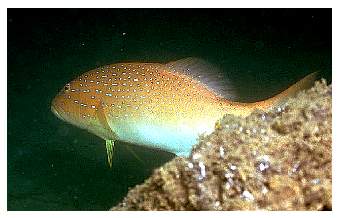 |
|
Before the Randall and Hoese revision of the genus,
Plectropomus maculatus was considered to be a
variant of P. leopardus.
Photo courtesy of David Cook.
|
Compatibility
chart for Plectropomus species:
| Fish |
Will
Co-Exist
|
May
Co-Exist
|
Will
Not Co-Exist
|
Notes |
| Angels,
Dwarf |
|
|
X
|
Will
be consumed by Plectropomus species. |
| Angels,
Large |
|
X
|
|
Large
adult individuals can be successfully mixed until the
Coral Grouper outgrows its tankmate. |
| Anthias |
|
|
X
|
Will
be consumed by Plectropomus species. |
| Assessors |
|
|
X
|
Will
be consumed by Plectropomus species. |
| Basses |
|
|
X
|
Will
be consumed by Plectropomus species. |
| Batfish |
|
|
X
|
Will
be consumed by Plectropomus species. |
| Blennies |
|
|
X
|
Will
be consumed by Plectropomus species. |
| Boxfishes |
|
X
|
|
Large
adult individuals can be successfully mixed until the
Coral Grouper outgrows its tankmate. |
| Butterflies |
|
X
|
|
Large
adult individuals can be successfully mixed until the
Coral Grouper outgrows its tankmate. |
| Cardinals |
|
|
X
|
Will
be consumed by Plectropomus species. |
| Catfish |
|
|
X
|
Will
be consumed by Plectropomus species. |
| Comet |
|
|
X
|
Will
be consumed by Plectropomus species. |
| Cowfish |
|
|
X
|
Will
be consumed by Plectropomus species. |
| Damsels |
|
|
X
|
Will
be consumed by Plectropomus species. |
| Dottybacks |
|
|
X
|
Will
be consumed by Plectropomus species. |
| Dragonets |
|
|
X
|
Will
be consumed by Plectropomus species. |
| Drums |
|
X
|
|
Large
adult individuals can be successfully mixed until the
Coral Grouper outgrows its tankmate. |
| Eels |
|
X
|
|
Large
adult individuals can be successfully mixed until the
Coral Grouper outgrows its tankmate. |
| Filefish |
|
|
X
|
Will
be consumed by Plectropomus species. |
| Frogfish |
|
|
X
|
Will
be consumed by Plectropomus species. |
| Goatfish |
|
X
|
|
Large
adult individuals can be successfully mixed until the
Coral Grouper outgrows its tankmate. |
| Gobies |
|
|
X
|
Will
be consumed by Plectropomus species. |
| Grammas |
|
|
X
|
Will
be consumed by Plectropomus species. |
| Groupers |
|
X
|
|
Large
adult individuals can be successfully mixed until the
Coral Grouper outgrows its tankmate. |
| Hamlets |
|
|
X
|
Will
be consumed by Plectropomus species. |
| Hawkfish |
|
|
X
|
Will
be consumed by Plectropomus species. |
| Jawfish |
|
|
X
|
Will
be consumed by Plectropomus species. |
| Lionfish |
|
X
|
|
Large
adult individuals can be successfully mixed until the
Coral Grouper outgrows its tankmate. |
| Parrotfish |
|
X
|
|
Large
adult individuals can be successfully mixed until the
Coral Grouper outgrows its tankmate. |
| Pineapple
Fish |
|
|
X
|
Will
be consumed by Plectropomus species. |
| Pipefish |
|
|
X
|
Will
be consumed by Plectropomus species. |
| Puffers |
|
X
|
|
Large
adult individuals can be successfully mixed until the
Coral Grouper outgrows its tankmate. |
| Rabbitfish |
|
X
|
|
Large
adult individuals can be successfully mixed until the
Coral Grouper outgrows its tankmate. |
| Sand
Perches |
|
|
X
|
Will
be consumed by Plectropomus species. |
| Scorpionfish |
|
X
|
|
Large
adult individuals can be successfully mixed until the
Coral Grouper outgrows its tankmate. |
| Seahorses |
|
|
X
|
Will
be consumed by Plectropomus species. |
| Snappers |
|
X
|
|
Large
adult individuals can be successfully mixed until the
Coral Grouper outgrows its tankmate. |
| Soapfishes |
|
|
X
|
Will
be consumed by Plectropomus species. |
| Soldierfish |
|
|
X
|
Will
be consumed by Plectropomus species. |
| Spinecheeks |
|
|
X
|
Will
be consumed by Plectropomus species. |
| Squirrelfish |
|
|
X
|
Will
be consumed by Plectropomus species. |
| Surgeonfish |
|
X
|
|
Large
adult individuals can be successfully mixed until the
Coral Grouper outgrows its tankmate. |
| Sweetlips |
|
X
|
|
Large
adult individuals can be successfully mixed until the
Coral Grouper outgrows its tankmate. |
| Tilefish |
|
|
X
|
Will
be consumed by Plectropomus species. |
| Toadfish |
|
|
X
|
Will
be consumed by Plectropomus species. |
| Triggerfish |
|
X
|
|
Large
adult individuals can be successfully mixed until the
Coral Grouper outgrows its tankmate. |
| Waspfish |
|
|
X
|
Will
be consumed by Plectropomus species. |
| Wrasses |
|
X
|
|
Large
adult individuals can be successfully mixed until the
Coral Grouper outgrows its tankmate. |
Note: While many of the fish are listed
as possible tankmates for Plectropomus species, you
should research each fish individually before adding it to
your aquarium. Some of the mentioned fish are better left
in the ocean or for advanced aquarists.
Of course, it bears mention that Coral
Groupers are not your normal aquarium fish, while the vast
majority of the fishes presented in the list above are, in
fact, regularly encountered aquarium fish. This column has
been composed mostly to toss out warning signs to unsuspecting
newbies who were duped into buying a juvenile, but I have
to consider that some people do have the resources necessary
to care for these fish. In that instance sharks and rays would
likely make superb tankmates, provided the aquarium's size
and filtration were adequate for all the tank's residents.
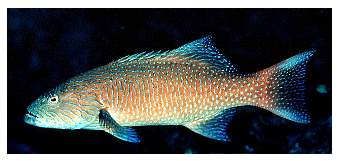 |
Plectropomus oligacanthus is the rarest of the
genus and is, therefore, not a frequent import for the
aquarium trade. Photo courtesy of John Randall. |
The aquarium décor's design is vital.
The Coral Grouper requires two distinct biotopes in the same
aquarium to truly feel comfortable. First, it requires a reef
wall which it can dive into and sleep behind. This means that
it requires an opening large enough for the fish not only
to fit through, but to have the ability to bolt into when
frightened. Additionally, the area behind the wall must be
large enough to house the grouper with enough space for it
to turn around. The option of mostly, if not entirely, obstructing
this area from lighting would be ideal. The second biotope
will be a large, open sand area. A rock scattered here or
there, or possibly even a single pillar, is okay; remember,
however, that your goal is to provide open swimming area so
the more rock added, the further from that objective you move.
Meet the Species
The least common
Plectropomus in the wild (minus the sub-species P.
pessuliferus pessuliferus) is P. oligacanthus,
but this does not necessarily mean that this species is uncommon
in the aquarium trade. Like all the other Coral Groupers,
this fish often appears as an adorable juvenile in local stores.
The very distinguishable elevated anterior soft portions of
its dorsal and anal fins have elicited the common name by
which it is referred to in the aquarium trade - Highfin Coral
Grouper. These elevated portions of the fin are unique to
the Highfin Grouper, thereby making it the most easily identifiable
Plectropomus species. At barely 24" of adult length,
it remains one of the smaller Coral Groupers.
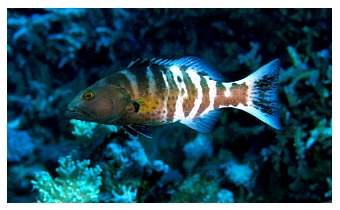 |
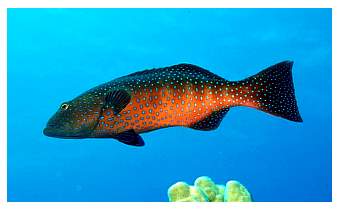 |
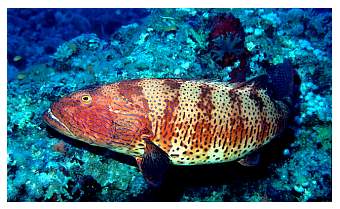 |
Both subspecies of Plectropomus pessuliferus
can be seen here. Plectropomus pessuliferus marisrubri
is easily recognized as having from 30 – 50 blue
spots on the cheeks, while P. pessuliferus pessuliferus
often has less than 10 spots per cheek. Photos courtesy
of Richard
Field.
|
A highly attractive member of the genus
is the Leopard Coral Grouper, or Plectropomus leopardus
for the ichthyologist types. At just over two feet in length
it is another smaller member of the genus, although the term
smaller is not exactly descriptive in this instance.
Due to the vast territory to which this species is indigenous,
it appears in the aquarium trade only occasionally. Unlike
many groupers which kick into predator mode once the sun sets,
Choat (1968) observed this species comfortably asleep during
the night hours. Extensive studies of P. leopardus'
home range effectively put the size of our home aquariums
into perspective. Although the exact size varied with no correlation
to the fish's age or size, a mean home range fell into the
10,000 to 18,000 m2 range. Additionally, the average Leopard
Grouper swam roughly 630' per day while one specimen, who
apparently was trying to fit into a bikini, swam over 3,600'
per day (Michael, 2004). That is a lot of laps around a 10'
long aquarium.
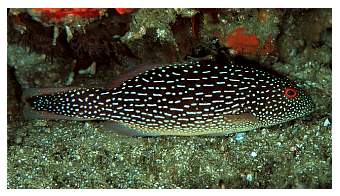 |
|
As a shallow water fish, Plectropomus punctatus
is easily captured by fish collectors. Of the nearly
60 specimens captured for research, none were deeper
than 33 feet. Photo courtesy of Dennis Polack.
|
The most popular species imported into
the United States is Plectropomus laevis. The Black
Saddle Grouper, as it is more commonly called, is one of the
genus' larger members, attaining lengths of over 40".
Its two distinct color phases kept ichthyologists guessing
for nearly two centuries. One author (Gunther, 1867) even
named this species as having a total of seven distinct species!
This species usually cruises outer reef areas several feet
off the sand bottom.
|
Plectropomus laevis exhibits two distinct color
varieties, both of which are extremely attractive. Both
color variations can often be found on the same reefs.
Photos courtesy of John Randall.
|
Conclusion
If big
is your thing, look no further; Coral Groupers definitely
fit your criteria. Preparation is key, however, when attempting
to tackle a fish that becomes as large as Plectropomus
species do. An enormous aquarium with a food budget to match
are the two most important considerations, but your work doesn't
stop there. Careful consideration must also be given to fellow
tankmates if you expect not to feed your other decorative
fish to your grouper.
Now, if you purchased one of these fish
upon your local store's recommendation, this column should
have shed some light onto your impulse purchase, not to mention
your local store's intentions and knowledge, or both. At this
point you need to honestly consider your ability to provide
for this fish long-term. For the vast majority of hobbyists
this means finding other housing arrangements for this fish
in the nearly immediate future.
|

